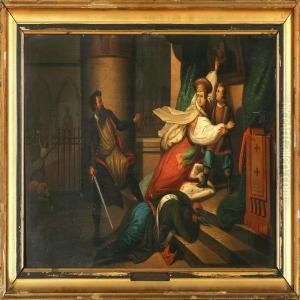Charles Guillaume Steuben Paintings
Charles Guillaume Steuben, also known as Carl Wilhelm Steuben, was a French painter born on April 18, 1788, in Landau in the Rhineland Palatinate, which was then part of France. His upbringing was influenced by the French Revolution and the Napoleonic Wars, contexts that would later be reflected in his historical and military paintings.
Steuben moved to Paris to pursue his artistic education and became a student of François-André Vincent, but he was also influenced by the work of Jacques-Louis David. Steuben's early career was marked by his participation in several important exhibitions, such as the Paris Salon, where he showcased his work and gained recognition.
His paintings often depicted dramatic moments in history and mythology, characterized by emotion and meticulous detail, a blend of the neoclassical style and the emerging Romantic sensibilities of the time. Among his notable works are 'The Bivouac of Napoleon on the Battlefield of Wagram', which reflects his interest in heroic military subjects, and ‘The Death of Poniatowski’, a tribute to Polish general and prince Józef Poniatowski who died during the Battle of Leipzig.
Steuben’s works were not limited to historical and military subjects; he also painted portraits and was involved in the restoration of works of art, including the Galerie des Batailles at the Palace of Versailles. He was named a Chevalier of the Legion of Honour for his contributions to the arts, which was a significant honor during that time.
Charles Guillaume Steuben died on November 21, 1856, in Paris. Although not as widely known today as some of his contemporaries, Steuben's paintings remain significant for their historical representation and are preserved in various museums across France and beyond. His work provides an important insight into French painting during a period marked by political upheaval and the transition between neoclassicism and romanticism.
